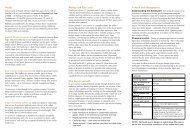Bushland Weeds Manual - Environmental Weeds Action Network
Bushland Weeds Manual - Environmental Weeds Action Network
Bushland Weeds Manual - Environmental Weeds Action Network
You also want an ePaper? Increase the reach of your titles
YUMPU automatically turns print PDFs into web optimized ePapers that Google loves.
64<br />
Chapter 5 Broadleaf Herbs, Sedges and Succulents<br />
Case Studies<br />
Euphorbia terracina invading the understorey of Tuart woodland at Bold Park.<br />
Case study 5.4 Typha orientalis – an aggressive coloniser of wetlands<br />
Two species of Typha are known<br />
from Western Australia,<br />
T. domingensis and T. orientalis.<br />
Native to eastern Australia,<br />
T. orientalis is thought to be<br />
introduced in Western Australia and<br />
it is an aggressive coloniser of<br />
wetlands of the Swan Coastal Plain<br />
and Jarrah Forest. Typha<br />
domingensis is native and occurs<br />
only occasionally in the region. The<br />
native and the weed can be difficult<br />
to tell apart.<br />
Typha domingensis has a<br />
leaf blade that does not<br />
exceed 8 mm in width<br />
and a cinnamon brown<br />
female flower spike that<br />
is 5 to 20 mm in diameter<br />
and 6 to 20 times as long<br />
as it is wide.<br />
Typha orientalis has a leaf<br />
blade up to 14 mm wide<br />
with a chestnut brown<br />
female flower that is 10 to<br />
30 mm in diameter and 5<br />
to 10 times as long as it is<br />
wide. Intermediates exist<br />
and expert help is<br />
sometimes required for<br />
identification.<br />
Life-cycle and Reproductive<br />
Biology of Typha orientalis<br />
• Expansion of existing<br />
populations is rapid, occurring<br />
via rhizomes that grow out<br />
from the population each<br />
season. Establishment of new<br />
populations is via seed.<br />
• Typha orientalis can produce<br />
220,000 seed per flower head.<br />
The seed is very light and winddispersed,<br />
often over several<br />
kilometres. Seed also spreads<br />
via water and is moved around<br />
in mud on the feet of birds,<br />
livestock and humans.<br />
• Seed germination generally takes<br />
place from December to April.<br />
• High temperatures (above<br />
20° C) and high levels of light<br />
are required for germination.<br />
Seeds germinate in mud on the<br />
margins of waterways and,<br />
sometimes, under water (less<br />
than eight centimetres deep).<br />
• Once established, seedlings<br />
start producing rhizomes and<br />
the diameter of the plant can<br />
extend to three metres within<br />
the first year.<br />
The program has resulted in a<br />
significant reduction of Geraldton<br />
Carnation Weed invading the<br />
bushland in Kings Park.<br />
Effective management has relied on:<br />
• Recognising, recording and<br />
removing new infestations.<br />
• Revisiting known populations<br />
year after year (for at least five<br />
years) following up previous<br />
work.<br />
(From Dixon 2000)<br />
Cautionary note: The sap in the stems of<br />
Euphorbia terracina is highly caustic and<br />
can cause quite dramatic and painful<br />
inflammations of sensitive skin. If the sap<br />
gets into the eyes temporary blindness is<br />
often reported and in some severe cases<br />
varying vision loss has been reported. When<br />
working with this plant, or any Euphorbia,<br />
care should be taken to minimise direct<br />
contact with the plant. Safety glasses or face<br />
shields and gloves, at a minimum, with fully<br />
enclosed shoes and neck to wrist to ankle<br />
protection is advised.<br />
• Active growth is mainly<br />
through summer and autumn<br />
although in mild climates it can<br />
occur at any time of the year.<br />
• Flowering commences in early<br />
summer and seed is dispersed<br />
from December onwards.<br />
(from Parsons and Cuthbertson 2001)<br />
Establishment and spread of<br />
Typha orientalis at Lake<br />
Forrestdale<br />
A study based on a series of aerial<br />
photographs of Lake Forrestdale<br />
just south of Perth illustrates how<br />
quickly the weed can spread once<br />
established at a site (Watkins and<br />
McNee 1985). The aerial photos<br />
revealed that prior to 1964 no<br />
T. orientalis occurred at the lake,<br />
with the first stand appearing in<br />
1967. By 1976 a fairly large stand<br />
had established on the southern<br />
end of the lake and by 1984<br />
T. orientalis had colonised almost<br />
the entire six kilometres of lake<br />
margin. Dense colonies had in many<br />
places displaced the native rushes<br />
and sedges in the understorey of<br />
the Melaleuca woodland fringing the



